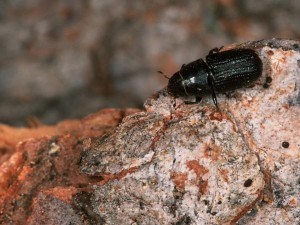
There’s a tiny menace making its way through Jasper National Park. It moves in swarms, and last year it killed almost 2,000 trees as it swept east.
The mountain pine beetle is by no means a new phenomenon in Jasper, but the rate at which its population is increasing has Parks Canada representatives stepping up their population control game.
When Parks lost funding that allowed it to undertake measures to control the beetle in 2008, populations in the park began slowly rising.
Parks representative Kim Weir explained that in the past Parks would count about 200 trees killed by the bugs each year. In 2012 that number doubled to about 400, and in 2013 it rocketed to 1,900.
Parks tracks the pest’s population by conducting aerial flyovers of the park’s forests. They count “red and dead” pine trees, and that number provides a benchmark for how fast the population is growing.
Mountain pine beetles kill trees by burrowing under their bark and laying eggs. When they hatch, young beetles munch around the perimeter of the tree, slowly cutting off the “supply lines” it uses to carry nutrients and water up its trunk. Some beetles also carry a deadly blue fungus, which can spread through the tree and further clog its arteries.
Because of these factors, Weir said that it takes only “a few” of the pests to completely kill a tree—a process that happens over the course of a year.
The rise in mountain pine beetle population is significant, but considering the condition of Jasper’s forests, not that surprising.
Weir explained that about 70 years ago officials in Alberta and B.C. began suppressing forest fires in earnest.
Without natural fires thinning out the woods and gobbling up old growth, young, vibrant trees haven’t had the break they’re needed to establish themselves, while older, more mature trees have continued to grow, becoming more prevalent than they otherwise would be.
Parks has only recently started introducing fire back into the environment in a controlled way, which means that right now Jasper’s forests contain a lot of mature trees.
And pine beetles are the happiest when they’re munching on them, especially ones that are 80 to 100 years old—the ones that have more nutrients buried under their bark, and that are less able to defend themselves.
That means that right now Jasper’s forests are a veritable buffet for the hungry bugs.
Combine that with seasons of warming weather, and it creates the perfect set of conditions for the beetle to thrive.
Pine beetles can produce a kind of natural anti-freeze when they feel the cold weather coming on. This glycerol helps them survive the coldest months, unless a snap of extremely frigid weather hits. In the past those -40° C snaps were fairly frequent. But in today’s warming climate, they’re not.
And while the population explosion concerns many outside the park, Weir said that the beetles are a natural part of Jasper’s environment, so Parks isn’t particularly concerned with an increase in their numbers inside park boundaries.
“We’ve created basically the perfect habitat for the mountain pine beetle,” Weir said. “They’ve always been here—they’re just kind of doing what they’ve always been doing. Really it’s the forest conditions that have changed.”
Back when Parks had funding for more management programs, winter crews were able to cut and burn the 200 affected trees each year, effectively keeping a lid on the pine beetle population. Now, Weir said Parks’ primary management tool is prescribed burns.
Fire officials set small fires in strategic locations to help thin out the forests and create a pine beetle barrier that will hopefully keep the bugs from sweeping through the park and into provincial lands, where they could potentially wreak havoc on the forestry industry.
Weir explained that if it weren’t for concerns about the forests outside the park, Parks officials in Jasper would likely let the beetle run its course here. After all, it is a natural part of the environment.
“Forest insects and disease, just like fire, are actually an important natural process. So in national parks we generally let processes proceed uninhibited, just because they are a natural and important part of the landscape,” she said.
Trevor Nichols
[email protected]
